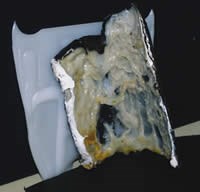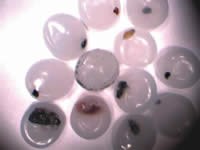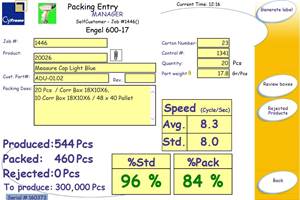Control Oxidation of HDPE Parts
For blow molders of HDPE parts, this is an all-too familiar sight at start-up time on Monday morning: The machine is purging leftover material onto the floor.
For blow molders of HDPE parts, this is an all-too familiar sight at start-up time on Monday morning: The machine is purging leftover material onto the floor. The purge is contaminated with oxidized resin that goes by several other names—burn, gels, yellow “snot,” and brown or black specks. The lost material hopefully goes to a recycler but most often ends up in a dumpster. It represents a waste of material, energy, and money.
NATURE OF THE PROBLEM
Like other organic materials, HDPE will char and turn black after a certain amount of heat exposure. Once oxidized, the material wants to stick to metal in the flow path, which results in more oxidation and, eventually, burning. Thus, the first priority is to prevent the initial oxidation from occurring.
Blow molding grades of HDPE are among the most robustly stabilized against oxidation, because up to 35% regrind is typically used in this process. This multiple-pass use of regrind is unique to blow molding and is unlike any other conversion method. But poor operating and maintenance procedures can consume the antioxidant protection and lead to burning. Figure 1 shows a bottle blow-out caused by burn contamination. The leak detector caught this bad part. Even more problematic is an HDPE bottle that turns into a “weeper” while in storage. These types of problems can be avoided by employing special monitoring techniques and process procedures to help control oxidation.
OPERATING PROCEDURES
Since cooling times determine the overall molding cycle, it makes economic sense to put the least amount of heat possible into the melt so there is less to remove. A cooler melt also minimizes the rate of oxidation.
But there are limits on how low you can go, such as excessive amperage on the drive motor and excessive head pressure. Too low a melt temperature can also lead to poor rewelding of the melt at the knit line or in the pinch-off. Loss of gloss and thin corners due to poor extensibility of the melt also put limits on reducing melt temperature.
Melt is heated by shear forces inside the machine, not just by the heater bands on the outside. Fill pressure for accumulator machines and backpressure for reciprocating-screw units should be kept as low as possible to minimize shear heating.
Another familiar factory scenario illustrates how oxidation can occur. The mold-change crew gets a late start due to other issues and then snaps a head bolt. It is now 7:30 p.m. and everyone is tired, so the decision is made to leave the line down for the night and finish up in the morning. No one remembers to turn the heat down before quitting, and there are no orders in the night log to purge the machine intermittently during the night. Prolonged idle periods lead to oxidation (Fig. 2).
START-UP & MAINTENANCE
A 35- or 50-lb head cannot come up to temperature as fast as a 120-mm or 150-mm extruder, so why start heating both at the same time? That just leaves melt baking in the extruder while the head warms up.
Alternatively, use a two-step ramp-up profile when you set up your extruder temperatures. Once the operating temperatures and soak-in times are reached, start the machine up promptly. If you can’t start molding right away, use periodic purges to keep fresh resin in the barrel and head.
Keep your temperature controllers calibrated. If a barrel cooling system is provided, make sure it works as designed. Keep an eye on screw and barrel wear by keeping an output test log for each machine. Backflow over worn screw flights requires more rpm to deliver melt at the same rate and causes a great deal of localized shear heating. Heat-zone temperature override is the usual symptom of a worn screw and often leads to burning problems.
If the screw is pulled, record the flight diameters. A simple examination for barrel wear can be made with a cylindrical object of slightly smaller diameter than the barrel I.D., such as a 0.75-in drive socket with a strong light source at one end. Any visible increase in light leakage around the object as it is slid down the barrel indicates wear.
And be careful about creating wear in the head. It eventually will have to be taken apart for cleaning. Respect its precise fit, sharp edges, and polished surface. Avoid powered wire brushes.
RESPONSIBLE SHUTDOWN
When it comes to shutdown, probably the worst thing you can do is flip the machine’s power off and walk away. Yet this is not uncommon. Although blow molding grades are well stabilized with antioxidant additives, the antioxidant is gradually consumed during heat exposure. So regrind, which may have been through several heat histories, does not have the same oxidation protection as virgin resin. Thus, it makes sense to stop the regrind feed prior to shutdown, leaving only virgin in the system.
The same goes for color concentrate. The carrier resin for the concentrate is not normally a blow molding grade with a robust antioxidant level. Film-grade resin is commonly used as the carrier and has less antioxidant protection.
If possible, drop the heat levels on shutdown by 50° to 75° F and turn on the cooling system. Purging at low rpm will remove latent heat from the system, but watch the amps on the extruder drive motor so you don’t overload it.
Banking the heat at approximately 100° below operating setpoint is preferable to going completely cold. Maintaining the melt in a semi-fluid state blocks oxygen entry, especially in the head. Once the head goes cold, the resin solidifies and shrinks away, providing an entry path and creating an air gap that heat must jump across on restart. But if you must go cold, leave the head and screw full of resin to block air entry and use the parison programmer to close the die gap.
Lastly, the opportunity for oxidation is not limited just to the blow molding process. The resin manufacturer also applies heat during pelletizing and burn can occur during that step. So be sure to check the incoming resin (Fig. 3).
And don’t regrind your rejected parts if they contain black specs or other degraded resin. The specs or gels will only come back later in another part.
About the Author
Robert DeLong has more than 50 years’ experience in plastics, much of it in blow molding. He began his work in blow molding at Hercules in 1956, molding what was then experimental PP on a hand-operated Plax machine. Since then he has worked in machinery, plant operations, and material development at Rainville Corp., Owens-Illinois, Captive Plastics, and Solvay and its successor companies. He was elected an SPE Fellow in 2003 and was awarded a Lifetime Achievement Award by the SPE Blow Molding Div. in 2004. He now runs Blasformen Consulting in Kingwood, Tex., and can be reached at (281) 360-5333 or by e-mail at done7106@earthlink.net.
Related Content
50 Years...600 Issues...and Still Counting
Matt Naitove marks his first half-century in plastics reporting, with a few of his favorite headlines.
Read MoreUse Interactive Production Scheduling to Improve Your Plant's Efficiencies
When evaluating ERP solutions, consider the power of interactive production scheduling to effectively plan and allocate primary and secondary equipment, materials and resources on the overall production capacity of the business and conclude that this is a key area that cannot be overlooked.
Read MoreProcessing Megatrends Drive New Product Developments at NPE2024
It’s all about sustainability and the circular economy, and it will be on display in Orlando across all the major processes. But there will be plenty to see in automation, AI and machine learning as well.
Read MoreHow to Extrusion Blow Mold PHA/PLA Blends
You need to pay attention to the inherent characteristics of biopolymers PHA/PLA materials when setting process parameters to realize better and more consistent outcomes.
Read MoreRead Next
Lead the Conversation, Change the Conversation
Coverage of single-use plastics can be both misleading and demoralizing. Here are 10 tips for changing the perception of the plastics industry at your company and in your community.
Read MoreTroubleshooting Screw and Barrel Wear in Extrusion
Extruder screws and barrels will wear over time. If you are seeing a reduction in specific rate and higher discharge temperatures, wear is the likely culprit.
Read MoreHow Polymer Melts in Single-Screw Extruders
Understanding how polymer melts in a single-screw extruder could help you optimize your screw design to eliminate defect-causing solid polymer fragments.
Read More
































